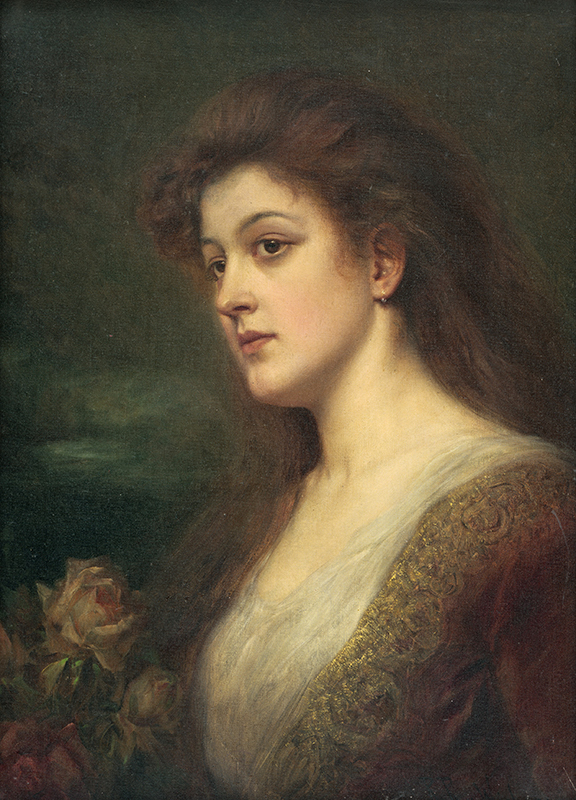Raimund Wichera’s Portrait of a Woman with a Rose has been donated to Nitra Gallery’s collection by the artist’s niece Malvína Wicherová (born 1886) who inherited the images from the Wichera siblings – her mother Vilemína (born 1858) and uncle Ferdinand (born 1864) who was a photographer. She had donated several of the paintings to the National Museum in Bojnice, some of which were transferred to Nitra Gallery’s collections in 1967 and 1969.
Considering the painting does not carry any date or signature, we can only assume it was created some time in the 1880s during the artist’s early creative period. The timeframe is formally referenced by a related image titled Woman’s Head which is a part of the Moravian Gallery collection in Brno and signed R. v. Wichera and dated to 18831. The argument is supported by the fact it was created two years after the artist’s studies finished (1881). While Wichera’s early paintings were heavily influenced by his mentor prof. Hans Makart and carry signs of portrait realism, his later images from the 1890s, when he was working in Vienna, are more romanticised and stylised portraits of young girls and women with flower bouquets – from today’s perspective, we would consider them “mainstream” portrait styles. He also worked on historical paintings and still lifes.
The Portrait of a Woman with a Rose captures a young woman dressed in period clothes with a bouquet of roses. She is pictured in a partial profile (a half-profile) with a daydreaming expression, gazing outside of the frame. The background is monochromatic, indistinct with a specific kind of atmosphere evoked using the painting strategy of chiaroscuro. The colours of the background, clothes and hair blend together. The portrait is painted in warm colours using earthy tones which highlight the woman’s face and cleavage painted with smooth brush strokes. The portrait is not staged or romanticised, featuring a very natural posture and face expression. The informal and leisure style is also supported by the loose hair which are very rare for the given period, especially when put in contrast with representative portraits featuring “cleaned up” period upstyles. The model’s natural character and the fact the paintings come from Wichera’s heritage suggest the person was very close to the artist, perhaps even a family member.
Raimund Josef Jan Wichera (as recorded in the register of births) was born on August 19, 1862 in Frenštát pod Radhoštěm and died in 1925 in Vienna. His painting talent started to show in his early childhood. From 1873 to 1876, he studied at a German secondary grammar school in the Moravian town of Hranice where his family had moved. His artistic efforts were supported by a professor of drawing of Czech nationality, the academic painter Jan Pinkava (1846 – 1923), but also František Watzlawik (Václavík, 1815 – 1893), an Austrian entrepreneur and politician with Czech origins who was the mayor of Hranice at the time and also an amateur painter – figuralist, who also taught young Wichera how to paint with oil colours. When he was 16, he was admitted to attend the Academy of Fine Arts in Vienna. At first, he studied general painting and later he majored in historical paining under professor Hans Makart (1878 – 1881). On the recommendation of his professor, the young painter was invited to teach drawing to the children of Franz Joseph I of Austria. Towards the end of the 1880s, Wichera returned to the town of Hranice where he set up a painting studio focusing mostly on portraits of Hranice’s town folk, but also officers of higher military schools based in the town. He also worked for the factory owner F. Kohn (Vsetín) and count Rudolf Vrba (Holešov) who introduced Wichera to the Hungarian-Croatian nobleman Juraj Drašković. He left for his castle in Hungary where he painted a ceremonial hall using historical motives; he also painted portraits of his family and other associated families.
In the 1890s, Wichera settled in Vienna. From the mid 1890s, he would use an aristocratic title of the Knight of Brennerstein he received based on the recommendation of Franz Joseph I of Austria. After being awarded with the title, he would use the signature R. R. v. W. (Raimund Ritter von Wichera). From 1901, he was a member of Wiener Kūnstlerhaus. He is considered an Austrian artist with Czech origins.
Wichera’s relationship with Slovakia is unclear. We know that Maximilán Raimund Gehér was born in 1890 in Štvrtok na Ostrove. He was the illegitimate child of Raimund Wichera and Paulina Geher who was adopted by Paulina’s later husband, Július Schurmann. Wichera supported his son Maximilán Schurmann (1890 – 1960), an important Slovak painter, during his studies at the Academy of Fine Arts in Vienna (1907 – 1911).
Barbora Geržová
December 2020
Sources
1 http://sbirky.moravska-galerie.cz/dielo/CZE:MG.M_163
Bibliography
Indra, Bohumír: Rodina Wicherů ve Frenštátě p. R. a v Hranicích a vídeňský akad. malíř Raimund Wichera [The Wichera Family in Frenštát p. R. and in Hranice and the Vienna academic painter Raimund Wichera]. In: Časopis Slezského muzea [Silesian Museum Magazine]. B Series – historical sciences 43, Vol. 2, 1994, p. 136 – 142.
Sedlářová, Jitka – Kačer, Jaroslav: Výtvarné umění Moravy 1880 – 1920 [Moravian Fine Art 1880-1920]. Exhibition Catalogue. Brno: Moravian Gallery, 1994.
Inventory No.: O-1016
Artist: Raimund Ritter von Brennerstein Wichera
Title: Portrait of a Woman with a Rose
Year: 1880s
Technique: oil
Material: canvas
Dimensions: 60,5 × 45,5 cm
Signature: none
